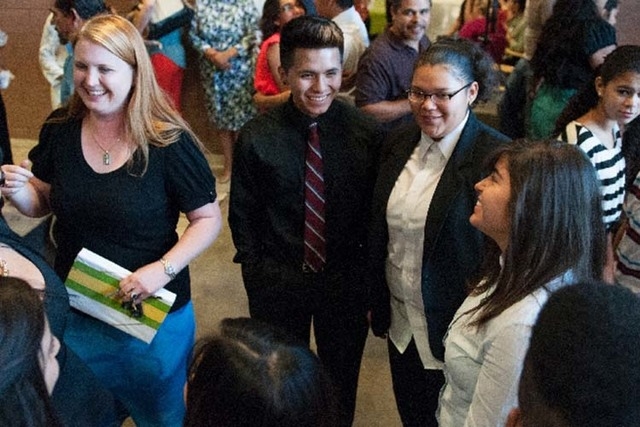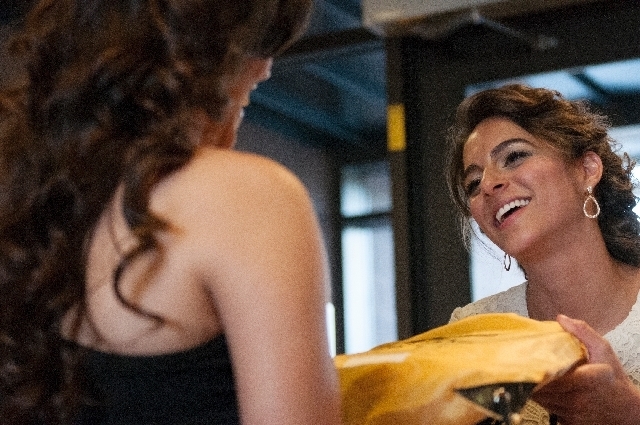Colleges offer students bridge to success
The Silver State isn’t known for student success.
Year after year, the state brings up the rear of education rankings. In Nevada, students routinely graduate unprepared for college, with many not completing a degree at all.
The 2013-14 Remedial Placement and Enrollment Report presented to the Legislature in July showed that the majority of incoming college students in the Las Vegas area require remedial classes. At the University of Nevada, Las Vegas, the rate was 56.7 percent for English, math or both subject areas. The rate was 80.9 percent at Nevada State College in Henderson and 54.1 percent at the College of Southern Nevada.
Colleges are striving for ways to help those students without saddling them with semesters of lower-level classes.
Enter summer bridge programs.
UNLV, CSN and Nevada State have programs designed to help at-risk high school students transition into college life. UNLV started a summer bridge “math boot camp” program in 2012 which has since been expanded to accommodate students in the fall, according to UNLV spokeswoman Afsha Bawany.
While UNLV ushers in students by the hundreds for its math-focused bridge program, CSN and Nevada State’s bridge programs serve a smaller set of students and champion a slightly different purpose: helping first-generation college students not only sharpen their academic skills but learn college survival skills.
CSN and Nevada State’s summer bridge programs just wrapped up their second year, and college officials like what they see. All those who did the schools’ summer bridge programs last year stuck it out through the academic year, according to the colleges.
MarYam Hamedani, associate director of Stanford’s Center for Comparative Studies in Race and Ethnicity, studies first-generation college students and agrees that seeing those students persevere is encouraging.
Bridge programs are great because they give students know-how and resources they otherwise might miss out on, she said.
“We’re all first-generation college students so we’re learning to take advantage of what’s offered to us,” Amallely Guitierrez, an 18-year-old graduate of Northwest Career and Technical Academy, said Aug. 7 during the program’s final day. She didn’t have any guidance, so the summer bridge program helped her learn what to expect.
Guitierrez’s answer is typical of students in CSN’s summer bridge program, who are quick to list exactly what they’re getting out of the program and how they plan to apply what they’ve learned. CSN’s two-week program took on 32 students this year. In its pilot year, it had 19 students.
Western High School graduate Fatima Rico, 18, said when she first took CSN’s math placement test she didn’t get the results she wanted. She didn’t study, and she didn’t take it as seriously as she should have, she said. That has changed. On the last day of summer bridge classes she quickly rattled off why acing a placement test is important: less time in school, more money saved. Rico said she’s confident she will do better when she retests.
The data on the program backs up Rico’s theory. The program found that 85 percent of its students who retook the math placement test scored two levels higher, according to CSN data.
“The program made me excited to start college,” Rico said earlier this month. “My mom is really hopeful now.”
Rico described her mother as “iffy” about the college idea. It wasn’t because she was a bad student, but she always just did the bare minimum, Rico said. The summer bridge program made her see how many options were available by putting in more effort, she said, and in turn gave her mother more confidence in her ability to excel in college.
“Now, she’s like ‘Let’s do this!’ ” Rico laughed.
Both CSN and Nevada State’s bridge programs are part of larger efforts to help first-generation college students succeed.
Nevada State’s six-week bridge program is part of its Nepantla program. Nepantla in the Aztec language Nahuatl means “in-between.” The term is used “to connote the space in which many first-generation and underrepresented college students find themselves located in, being ‘torn between worlds’ or ‘in between’ social locations,” according to Nevada State’s website. “The term connotes the transitions that many students face going from high school to higher education.”
The Nepantla program, which had 22 students in its bridge program this summer, offers students continued support throughout their academic careers.
CSN’s bridge program is part of the college’s TRiO program, a federally funded support services program designed to help disadvantaged students.
“They are so lost when they come to CSN — they just don’t know how to formulate their questions yet,” said Emily Rafael, director of CSN’s TRiO program. “We also give them the tools to believe in themselves.”
Hamedani said it was good that these bridge programs folded into longer-term support.
Retention rates and grades are good indicators that programs are helping, but an important part of helping first-generation students succeed is less measurable. Making sure programs offer support that empowers students and helps them feel like they belong is also critical, Hamedani said.
In college there are many unspoken and implicit norms other students pick up from family members, Hamedani said. First-generation college students often experience a culture clash between their home environments and their school environments.
Rico and her classmate, Fernando Varela-Moran, a Desert Pines High School graduate, said they were surprised at how simple it is to take initiative and do well by just asking for help.
“You really think that no one is on your side,” Rico said.
Her classmate agreed.
“I thought I’d be by myself,” Varela-Moran added.
Contact Bethany Barnes at bbarnes@reviewjournal.com or 702-477-3861. Find her on Twitter: @betsbarnes.





























